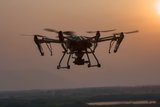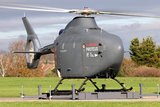ScanEagle completes hydrogen-powered fuel cell flight
Insitu has announced that the ScanEagle UAV has successfully completed its first hydrogen-powered fuel cell flight. The two-and-a-half-hour flight test marks an important step in the move toward hydrogen-powered fuel cell solutions as an alternative to expensive gas and heavy fuel solutions in UAVs.
According to the company, the hydrogen-powered fuel cell solution was implemented as a modular upgrade to the runway-independent, expeditionary Group 2 ScanEagle UAV. The collaboration between Insitu, Naval Research Laboratory (NRL) and United Technologies (UTC) took UTC's 1500 Watt (2 HP) fuel cell and integrated it with NRL's hydrogen fuelling solution into a ScanEagle propulsion module.
As well as increasing reliability and reducing operating costs, Insitu believes fuel cell technology will increase payload capacity and help simplify support logistics.
Insitu said that the US Department of Defence (DOD) recently laid out its vision for the role that fuel cells will play in improving mission capability. The fuel-cell powered flight of ScanEagle, demonstrates Insitu's continuing commitment to respond to the needs of its customers by introducing new technology into a modular system designed for expansion and growth.
Insitu is also collaborating with the Air Force Research Lab to flight test a fuel cell on the Integrator UAV later this year.
More from Uncrewed Vehicles
-
![What's next for the Pentagon after the Replicator programme?]()
What's next for the Pentagon after the Replicator programme?
Although the Replicator initiative has made several accomplishments, there are still multiple gaps to plug across the US Department of Defense (DoD) and its services.
-
![Cummings Aerospace showcases Hellhound loitering munition designed for US Army’s LASSO programme (video)]()
Cummings Aerospace showcases Hellhound loitering munition designed for US Army’s LASSO programme (video)
Cummings Aerospace presented its turbojet-powered Hellhound loitering munition at SOF Week 2025, offering a man-portable solution aligned with the US Army’s LASSO requirements.
-
![SOF Week 2025: PDW unveils attritable FPV drone for SOF operations at scale]()
SOF Week 2025: PDW unveils attritable FPV drone for SOF operations at scale
PDW has revealed its Attritable Multirotor First Person View drone at SOF Week 2025, offering special operations forces a low-cost, rapidly deployable platform for strike and ISR missions, inspired by battlefield lessons from Ukraine.
-
![SOF Week 2025: Teledyne FLIR white paper provides guidance on reusable loitering munitions]()
SOF Week 2025: Teledyne FLIR white paper provides guidance on reusable loitering munitions
Teledyne FLIR is highlighting the emerging requirements for 'recoverable and re-usable' loitering munitions across the contemporary operating environment during this week’s SOF Week conference in Tampa, Florida.
-
![SOF Week 2025: Kraken Technology group debuts K3 Scout USV in North America]()
SOF Week 2025: Kraken Technology group debuts K3 Scout USV in North America
High-performance maritime industry player Kraken Technology Group, based in the UK, has used the SOF Week conference in Tampa, Florida this week to debut its K3 Scout uncrewed surface vessel (USV) to the North American market.
-
![Palladyne AI and Red Cat to demonstrate capabilities for autonomous drone swarms to the US military]()
Palladyne AI and Red Cat to demonstrate capabilities for autonomous drone swarms to the US military
Red Cat and Palladyne AI recently conducted a cross-platform collaborative flight involving three diverse heterogeneous drones.

























